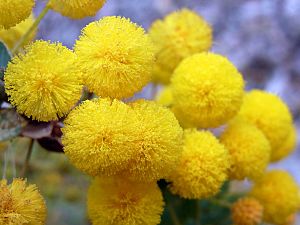Acacia cremiflora facts for kids
Quick facts for kids Acacia cremiflora |
|
|---|---|
 |
|
| Scientific classification | |
| Genus: |
Acacia
|
| Species: |
cremiflora
|
 |
|
| Occurrence data from AVH | |
Acacia cremiflora is a small wattle plant. It grows in some inland areas of New South Wales, Australia. You might spot it near towns like Orange and Yerranderie. This plant was first found and collected on May 15, 1972. It has pretty yellow or cream-colored flowers that can bloom at any time of the year.
What it Looks Like
This shrub usually looks like a bushy plant. It often grows less than 1 meter (about 3 feet) tall. Sometimes, it can reach up to 2 meters (about 6.5 feet) high. It often has five or six main branches that spread out from the bottom.
The branches stand upright or arch over. They split into smaller parts called branchlets. These branchlets are ribbed, brown to green, smooth, and sometimes a bit hairy.
Leaves and Flowers
The plant has dark grey-green or green "leaves." These are actually flattened leaf stems called phyllodes. They can be flat or slightly curved. Their shape is usually oval or broadly oval, sometimes almost round. These phyllodes are typically 7 to 17 millimeters long (about 0.3 to 0.7 inches). They are also 4 to 14 millimeters wide (about 0.15 to 0.55 inches). Their edges are wavy, and their tips are pointed.
When the plant flowers, it produces round clusters of blooms. These clusters are called inflorescences. Each flower-head is about 7 to 8 millimeters (about 0.3 inches) across. They contain 18 to 26 pale yellow to cream-colored flowers.
Seed Pods
After the flowers bloom, seed pods form. These pods are a dull brown to dark brown color. They are usually oblong or broadly oblong in shape. They can be straight or slightly curved. The pods are 40 to 80 millimeters long (about 1.5 to 3 inches). They are also 15 to 30 millimeters wide (about 0.6 to 1.2 inches). These pods are quite thick and leathery.
How it Got its Name
Scientists give every plant a special two-part name. This helps everyone know exactly which plant they are talking about. The Acacia cremiflora was first officially described in 1996. Two botanists, Barry John Conn and Terrence Michael Tame, did this work. They wrote about it in a science journal called Australian Systematic Botany.
For a short time in 2003, another botanist named Leslie Pedley changed its name to Racosperma cremiflorum. But in 2006, it was moved back to the Acacia group. So, its official name is still Acacia cremiflora.
Where it Grows
This shrub is endemic to inland parts of New South Wales. This means it only grows naturally in this area. You can find it from places like Uarby and Elong Elong in the north. It grows south to areas around Mudgee and Yerranderie. It can also be found as far west as Parkes.
In the northern areas, these plants often grow in woodlands. They are also found in open areas with trees and grass. Here, they prefer stony, clayey, or loamy soils. In the southern areas, they grow in Eucalyptus woodlands. The soil there is usually gravelly clay or sandy loam.

